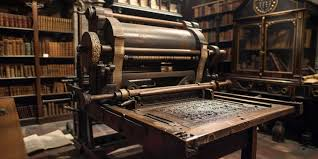Introduction
printing press is often hailed as one of the most transformative inventions in human history. Its emergence in medieval society was nothing short of revolutionary, reshaping the way information was disseminated, shared, and preserved. Let’s journey back to the Middle Ages to uncover the profound impact of this ingenious invention.
The Dawn of a New Era: Gutenberg’s Masterpiece

Before the printing press, books were painstakingly hand-copied by scribes. Imagine spending months or even years creating a single book! Then, Johannes Gutenberg came along in the mid-15th century with his movable type printing press, and the world was never the same.
Gutenberg’s invention wasn’t just a device; it was a gateway to knowledge. With this machine, books could be produced faster, cheaper, and more efficiently. The first major work printed was the Gutenberg Bible, a symbol of the printing press’s potential to spread religious and scholarly works widely.
Knowledge at Everyone’s Fingertips
The printing press democratized knowledge in ways previously unimaginable. Before its invention, literacy was largely the privilege of the elite and clergy. Books were rare treasures, locked away in monasteries or the homes of the wealthy.
But with the printing press, books became more accessible. As prices dropped, even common folk could afford them. This surge in availability inspired a thirst for knowledge, fueling education and literacy across Europe.
Religious Reformations: A New Voice for the Masses
One of the most profound impacts of the printing press was on religion. Martin Luther’s 95 Theses, nailed to a church door in 1517, sparked the Protestant Reformation. Yet, it wasn’t the act of nailing the document that changed the world it was the rapid spread of his ideas, thanks to the printing press.
Pamphlets, books, and translations of the Bible into vernacular languages flooded Europe. For the first time, ordinary people could read religious texts and form their own interpretations. The printing press, in essence, gave people a voice and challenged the monopoly of the Church.
The Birth of Modern Science
The Scientific Revolution owes much to the printing press. Scientists like Galileo, Copernicus, and Newton used printed books to share their findings. The ability to reproduce and distribute scientific works allowed ideas to build upon one another, accelerating progress.
Imagine if Copernicus’ heliocentric theory had remained a handwritten manuscript, gathering dust in a forgotten library. The printing press ensured that groundbreaking ideas reached a global audience, fostering collaboration and debate.
Cultural Renaissance: Art and Literature Flourish
The Renaissance was a cultural rebirth, and the printing press was its beating heart. Artists, writers, and thinkers found a powerful ally in the press. Works of literature like Dante’s Divine Comedy and Chaucer’s Canterbury Tales gained wider audiences.
Artistic techniques and discoveries were shared through printed manuals, allowing artists across Europe to learn and innovate. The press didn’t just spread culture it created a shared cultural identity.
Political Upheaval: Information as Power
With information now flowing freely, the printing press became a catalyst for political change. Monarchs and rulers no longer had a monopoly on knowledge. Political pamphlets and treatises circulated, challenging authority and inspiring revolutions.
For example, the English Civil War saw an explosion of printed propaganda from both royalist and parliamentarian sides. The press empowered citizens to question, debate, and demand accountability.
Economic Impact: A Boon for Trade and Commerce
The printing press also revolutionized commerce. Printed materials like trade manuals, maps, and financial documents facilitated business. Merchants could now access information about distant markets and trade routes, enhancing economic activity.
Moreover, the rise of printed advertisements opened new avenues for trade. Businesses began to market their goods and services to a broader audience, laying the groundwork for modern advertising.
Education Revolution: The Rise of Universities
With books more readily available, universities blossomed. The printing press provided students and teachers with access to texts that were once prohibitively expensive. This accessibility fueled a wave of intellectual growth and innovation.
Libraries expanded their collections, and scholars could now engage with a broader range of ideas. The press essentially became the backbone of academic progress.
Standardization of Knowledge
Before the printing press, variations in manuscripts led to inconsistencies in knowledge. Scribes often made errors or added personal interpretations. The printing press eliminated such discrepancies, standardizing texts and ensuring accuracy.
This consistency was particularly crucial for subjects like law, medicine, and science, where precision was paramount. The press thus laid the foundation for a more reliable transmission of knowledge.
Challenges and Controversies
Despite its many benefits, the printing press wasn’t without controversy. Authorities often viewed it as a double-edged sword. While it spread enlightenment, it also disseminated dissenting ideas and heresies.
To curb its influence, some governments and religious institutions imposed censorship. In extreme cases, books were banned or burned. Yet, such measures couldn’t suppress the relentless march of progress.
The Printing Press and Women
The printing press also impacted women, albeit in nuanced ways. While the initial rise in literacy primarily benefited men, women gradually gained access to printed materials. Books on domestic skills, religion, and literature became popular among women, subtly expanding their horizons.
Though still limited by societal norms, the press planted seeds of change, contributing to the slow rise of female education and empowerment.
A Step Towards Globalization
The printing press didn’t just affect Europe; it set the stage for global connections. Books, maps, and navigational charts enabled explorers like Christopher Columbus to venture into uncharted territories.
The exchange of printed knowledge between continents paved the way for globalization. Ideas, goods, and cultures began to intertwine, reshaping the world as we know it.
From Scrolls to Screens: A Legacy of Innovation
While the printing press revolutionized medieval society, its legacy endures. Today, we live in a digital age where information is instant and boundless. Yet, the principles of accessibility and dissemination championed by the printing press remain at the core of our information-driven world.
Think about it: every ebook, blog post, and tweet owes a debt to Gutenberg’s groundbreaking invention.
Conclusion: A Catalyst for Change
The printing press wasn’t just an invention; it was a catalyst for change. It broke down barriers, empowered individuals, and reshaped societies. From sparking revolutions to fostering scientific discovery, its impact on medieval society was profound and far-reaching.
As we reflect on this remarkable device, one thing is clear: the printing press didn’t just change the Middle Ages; it laid the foundation for the modern world.
Also Check: The African Diaspora’s Influence on Latin American Culture: A Story of Resilience
FAQs
1. What was the primary purpose of the printing press in medieval society? The printing press’s primary purpose was to mass-produce written works, making knowledge more accessible and affordable to a broader audience.
2. How did the printing press impact literacy rates? The printing press significantly boosted literacy rates by reducing the cost of books, allowing more people to access and learn from written materials.
3. What role did the printing press play in the Protestant Reformation? The printing press enabled the rapid spread of Martin Luther’s 95 Theses and other reformist ideas, challenging the Catholic Church’s authority and fueling the Protestant Reformation.
4. Were there any negative consequences of the printing press? Yes, the printing press also spread misinformation, heretical ideas, and propaganda. Authorities often responded with censorship and book bans.
5. How does the printing press’s legacy influence us today? The printing press laid the groundwork for modern information sharing, influencing everything from publishing to the digital revolution.


